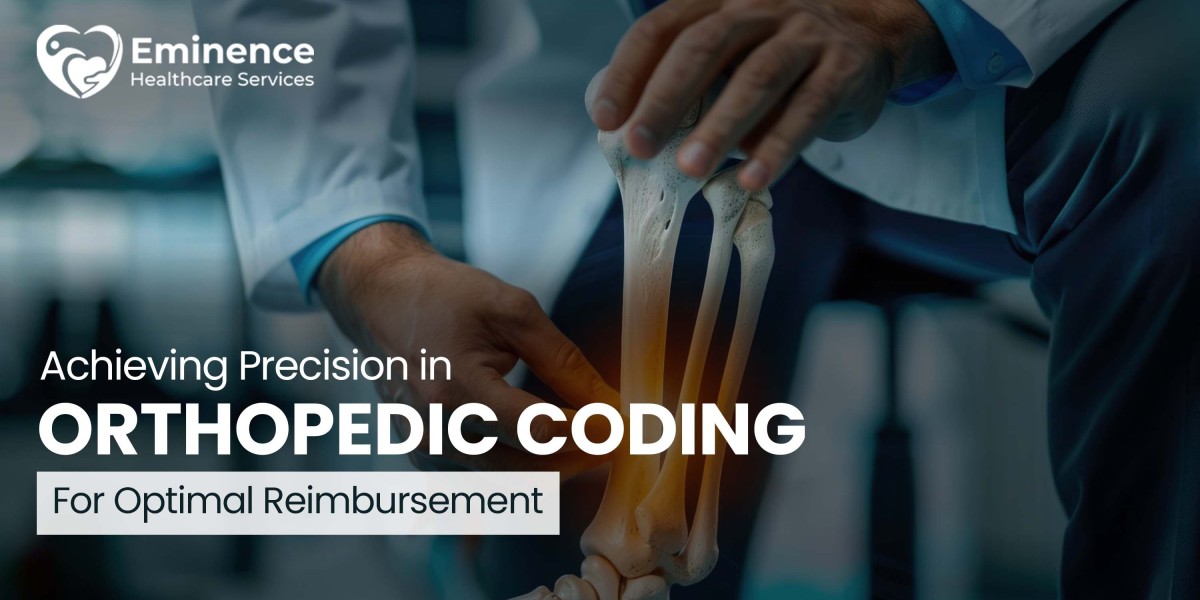https://eminencercm.com/blogs/achieving-precision-in-orthopedic-coding-for-optimal-reimbursement
When the goal is faster reimbursements, the strategy to reach there must also be efficient. In the case of orthopedic billing, ensuring accurate coding is the way to improve the revenue cycle and enhance operational efficiency.
For orthopedic practice, managing administrative tasks and attaining a streamlined process requires precision. Coding is just one aspect of medical billing, to ensure efficiency healthcare providers must take care of other steps in the process.
However, with accurate coding, an orthopedic practice can limit the number of denials and protect the practice from revenue leakages. All in all, optimizing a medical billing process is significant to the growth of orthopedic practice.
This blog highlights how orthopedic practices can streamline their medical billing process and achieve consistently accurate coding for comprehensive improvement.
Essential Factors of Orthopedic Billing and Coding
Medical billing and coding are major contributors to smooth-running orthopedic practice, and they include:
- Standard CPT and ICD – 10 codes for various treatments and procedures from the orthopedic medical specialty
- Accurate use of modifiers in case of changes in the course of orthopedic treatment
- Meeting regulatory standards and staying up to date with essential trends
- Ensuring recording and documentation of patient entry and treatment
Making sure that all these factors are handled well is the responsibility of healthcare providers. They can either manage everything themselves or hire a team for the administrative tasks.
Usually, healthcare providers have limited time, and they prefer handing over this task to medical billers and coders. Then, it is the function of these professionals to incorporate all vital features into medical coding and lead to adequate revenue.
If healthcare providers take care of orthopedic billing themselves, then ensuring some simple steps can optimize their practice and they can avoid complexities such as denials and revenue leakages.
Top Ways to Boost Orthopedic Billing and Ensure Robust Revenue Cycle
Following some beneficial practices can help healthcare providers improve their medical billing process and lead them to robust reimbursement. The tips to upgrade orthopedic billing are:
Maintaining Accuracy During the Collection of Patient Information
Maintaining accuracy during the collection of patient information is crucial to avoid errors in coding and denials. As this is the initial step in medical billing, setting the standard of accuracy can streamline medical billing steps.
Healthcare providers must ensure that their front office is proficient at recording this vital data. The staff needs to collect patient demographics such as contact details, medical history, and insurance data.
There can be many ways to attain accuracy, but healthcare providers can implement a double-check system to avoid errors or missing details. Healthcare practice can also promote digital recording of information to reduce the chances of manual errors.
On-point Documentation of Medical Necessity & Essential Patient Data
Documentation of patient information is important, and healthcare providers cannot neglect documentation of medical necessity. Medical necessity is a testament to insurance companies rendering orthopedic services.
Medical necessity clearly defines the condition of the patient and includes all details about the choice of treatments and procedures. In the process of medical billing, this documentation holds significance and that is why it must be on point.
Healthcare providers must ensure that this documentation is done with proficiency. Healthcare providers can use templates to maintain consistency in patient data documentation.
Checking & Acquiring Prior Authorization in the Initial Step
In the process of medical billing, healthcare providers cannot miss the crucial step of prior authorization. Obtaining prior authorization is about ensuring inclusion of medical necessity in insurance policy for orthopedic treatment.
Healthcare providers can hand over the task of acquiring prior authorization to billers who are well-versed with payer policies and insurance requirements for orthopedic treatment.
Obtaining prior authorization is essential to prevent denials as this is one of the major reasons for denials in orthopedic billing. Healthcare providers have to deal with these complex medical billing requirements to ensure adequate revenue and smooth operations.
Ensuring Submission of Claims Within the Specified Time Frame
Recording data, checking insurance terms and coding are important for faultless medical billing. However, healthcare providers must realize the significance of ensuring timely claim filing and submission.
If every medical billing step goes right but claims are not submitted on time, then they are bound to result in denials. This happens because insurance companies stipulate a time frame for submission and claims submitted after that time is denied.
For this, healthcare providers have to decide on a timeline to complete the entire medical billing process including claim submission. A healthcare practice must set some internal standards for claim filing and submission. They should monitor claims to find and rectify delays proactively. This way they can streamline claim submission and prevent denials.
Staying Current with Ever-changing Orthopedic Coding Guidelines
Another unavoidable part of orthopedic billing is staying current with regulatory guidelines. These guidelines can be the deciding factor for healthcare providers as they must update their medical billing method to ensure it meets recent standards.
To ensure accurate coding and billing within regulatory guidelines, healthcare providers must keep up with the below-mentioned authorities:
- American Academy of Orthopedic Surgeons (AAOS)
- American Health Information Management Association (AHIMA)
- American Academy of Professional Coders (AAPC)
- Centers for Medicare & Medicaid Services (CMS)
- Medicare Learning Network (MLN)
Essentials of Orthopedic Medical Coding
Healthcare providers need a coding guide to ensure accuracy. Here is the list of codes that healthcare providers must know:
Common Orthopedic CPT Codes
CPT (Common Procedure Terminology) codes describe the medical services rendered to the patients. These include orthopedic diagnosis, treatment and procedures.
Commonly used orthopedic CPT codes are:
Treatment of Fracture (Open) - 11010-11012
Arthrocentesis, Aspiration, Injection - 20600-20611
Spinal Fusion - 22554
Rotator Cuff Repair - 23410
Total Hip Arthroplasty - 27130
Total Knee Arthroplasty - 27447
Treatment of Fracture (Closed) - 28515
Knee Arthroscopy - 29877
ACL Repair - 29888
Carpal Tunnel Release - 64721
Common Orthopedic ICD-10 Codes
Other than CPT codes, ICD-10 codes are commonly used in orthopedic medical billing.
Such codes help healthcare providers to depict conditions in detail and accurately record a patient’s condition.
Commonly used ICD-10 codes are:
M17.10 - Unilateral primary osteoarthritis, unspecified knee
S72.001A - Fracture of unspecified part of neck of right femur, initial encounter for closed fracture
S83.522D - Sprain of posterior cruciate ligament of left knee, subsequent encounter
S43.421D - Sprain of right rotator cuff capsule, subsequent encounter
S43.422A - Sprain of left rotator cuff capsule, initial encounter
M67.02 - Short Achilles tendon (acquired), left ankle
Modifiers
When procedure codes need to show some additional information, they are paired with modifiers.
Modifiers are 2-digit codes that are added to the main procedure code. They signify additional information about rendered medical services to patients.
Some common modifiers for orthopedic billing are:
51 – If a healthcare provider performs multiple procedures within the same surgical session, then this modifier is added.
59 – This modifier is added to distinct/independent procedures conducted on the same day as others.
LT/RT - This modifier specifies the side of the body whether left or right. If the procedure is performed on the left side, it is denoted with LT otherwise it is denoted as RT.
50 – This modifier is bilateral, and it specifies that the procedure was performed on both sides of the body.
76 – This modifier signifies the repetition of a procedure by the same healthcare provider on the same day. It is used in case the procedure fails on the first attempt.
22 – If a procedure takes longer than the expected time then this modifier is added.
Achieve Revenue Cycle Success: Choose Eminence RCM as Your Orthopedic Billing Partner
Healthcare providers must take care of various things to ensure an accurate and efficient orthopedic billing process. Their focus is on improving the coding process and making it free from errors and missing details. It is also vital to ensure the correctness of CPT and ICD–10 codes along with essential modifiers.
It can be a lot for healthcare providers as they must provide quality care and ensure patient satisfaction. That is why healthcare providers and practices can get professional assistance from medical billing companies. They can shift their burden to expert billers and coders while eliminating the complexities in orthopedic billing.
Eminence RCM takes complete responsibility for your orthopedic practice and handles every aspect of medical billing. We specialize in addressing issues like errors and missing details to help you achieve robust revenue. Our team analyses your current revenue cycle management and imposes result-driven strategies to streamline the workflow.
We stay updated with frequent regulatory changes and adhere to the standards of HIPAA to ensure smooth operations and the protection of patient information.
At Eminence RCM, making sure our clients receive adequate revenue is the priority.



